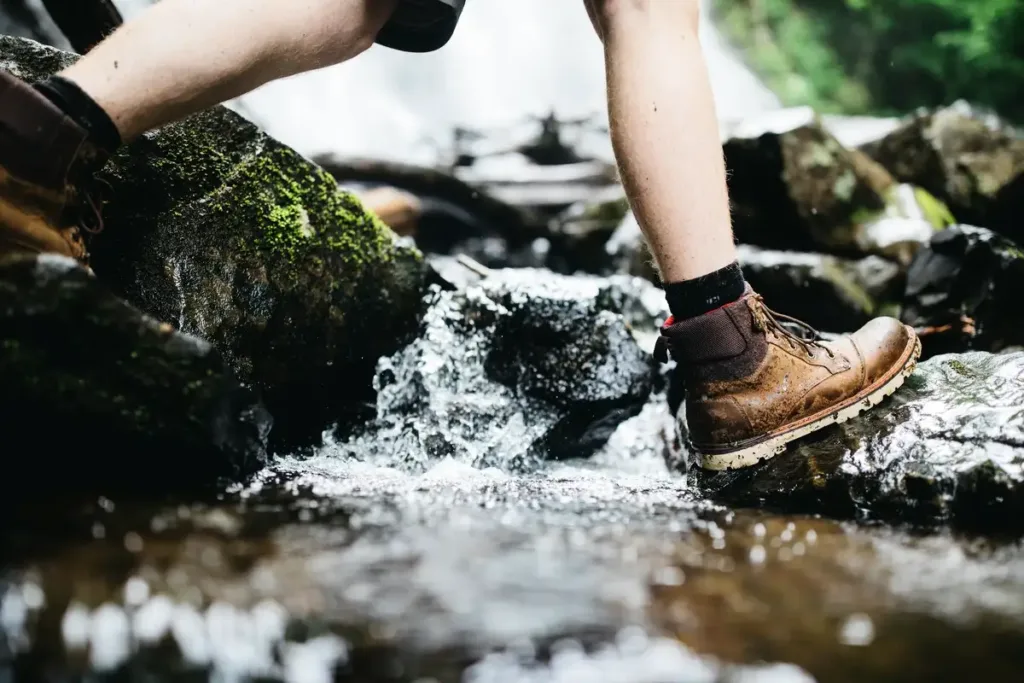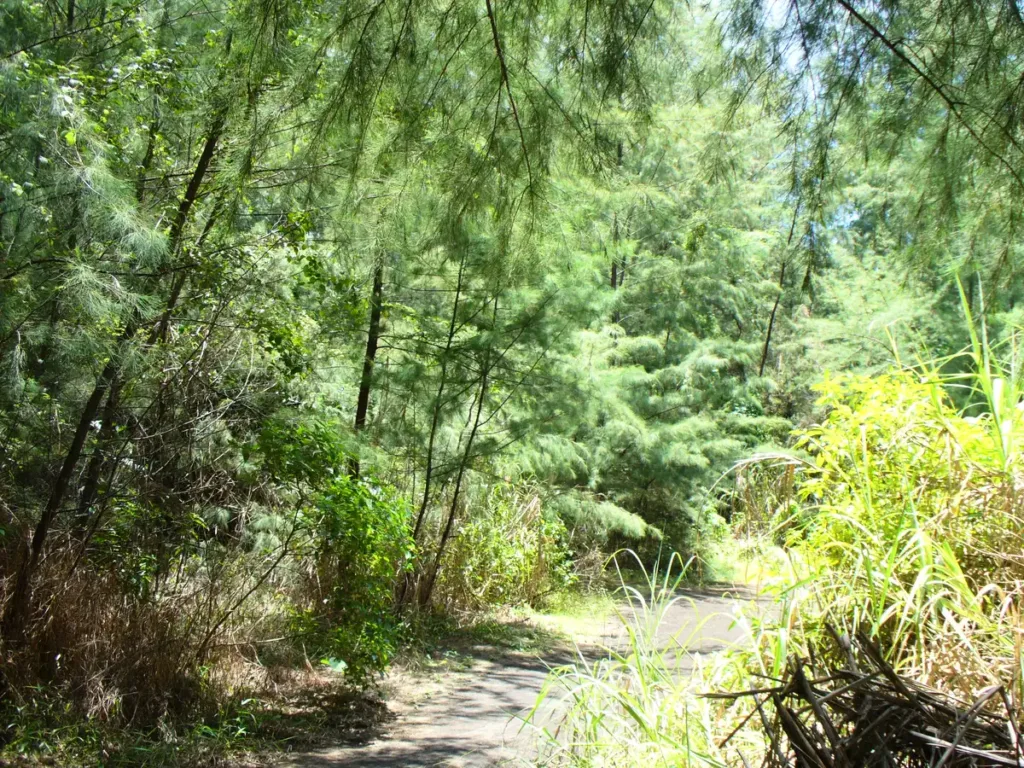Should you land on your heel or forefoot while walking?
This post may contain affiliate links. This means that we may receive a small commission from purchases through those links. Read more in our affiliate disclosure.
Maybe just switched to minimalist or zero-drop footwear, and suddenly, you’re hyperaware of every step you take. You might be wondering, “Am I doing this right?” Well, you’ve come to the right place! Let’s find out whether you should be landing on your forefoot or heel while walking.
The optimal foot strike while walking depends on several factors, including your footwear, the type of ground you’re walking on, the incline, and your walking speed. Traditional shoes with elevated heels encourage a heel strike, while zero-drop shoes or barefoot walking in many situations make a forefoot or midfoot strike more natural. Soft ground or uphill inclines might make a heel strike more comfortable, while for hard surfaces or downhill slopes, you’re better off using a forefoot or midfoot strike. Ultimately, the best foot strike is the one that feels most comfortable and efficient for you.

What is Natural Gait?
To truly understand natural gait, we need to take a step back – pun fully intended – and look at our ancestors.
Before the invention of the modern, cushioned footwear we’re so accustomed to, our ancestors walked and ran barefoot or in minimalist footwear. They didn’t have the luxury of thick soles or arch support. Instead, they relied on the strength and flexibility of their feet to navigate the world. This is the essence of natural gait.
In the book “Born to Run“, Christopher McDougall explores this concept beautifully. He delves into the world of the Tarahumara, a tribe known for their long-distance running abilities, all done in minimalist sandals. Their secret? A natural gait that relies on the forefoot or midfoot strike.
what is a forefoot, midfoot, or heel strike?
It’s all about which part of your foot hits the ground first.
In a forefoot strike, the ball of your foot – that’s the padded portion just before your toes begin – lands first, followed by the heel. It’s a bit like tiptoeing, but with the heel coming down after the initial landing.
A midfoot strike, on the other hand, is when the ball and heel of your foot land simultaneously. It’s a balanced, stable way of moving that evenly distributes the impact of each step.
And then, there’s the heel strike. This is when your heel touches the ground first, followed by the rest of your foot. It’s the most common foot strike pattern in the modern world, largely due to the design of our shoes.
Natural Gait While Running
When it comes to running, the natural gait takes on a whole new level of importance. The way your foot strikes the ground can significantly impact your running efficiency, speed, and risk of injury. And if you’re running barefoot or in zero-drop shoes, you’ll likely find that it’s most natural to land on your forefoot or midfoot rather than your heel.
Why is that, you might ask? Well, let’s look into the biomechanics of running.
When you run, each foot strike sends a shock wave up your body. This is the impact force, and it can be quite substantial – up to two to three times your body weight. Now, if you’re landing on your heel (a heel strike), this force goes straight up your leg, jarring your knees, hips, and even your back. Over time, this can lead to injuries.
On the other hand, when you land on your forefoot or midfoot, your foot and calf muscles act as natural shock absorbers. They compress and absorb the impact, reducing the force that reaches your joints. This can significantly lower your risk of running-related injuries.
But that’s not all. Forefoot and midfoot striking also encourage a shorter stride and faster cadence – that’s the number of steps you take per minute. A shorter, quicker stride can improve your running efficiency, making it easier to maintain your pace or even run faster.
And there’s another benefit to forefoot and midfoot striking. When you land on your forefoot or midfoot, your foot is in a better position to push off for the next stride. This can give your running a more fluid, springy feel, as if you’re bounding forward with each step.
But what about when you’re not running? What if you’re hiking or walking? Does the natural gait change?
Natural Gait While Walking
When it comes to walking, the natural gait can be a bit more complex. Unlike running, where a forefoot or midfoot strike is generally preferred, the optimal foot strike for walking can depend on several factors. Let’s explore these factors in more detail:
Footwear
The type of footwear you’re wearing can significantly influence your foot strike. Traditional shoes with elevated heels tend to encourage a heel strike. This is because the elevated heel acts as a sort of ramp, guiding your foot to land heel-first. So, if you’re wearing cushioned shoes with significantly elevated heels, heel-striking is really your only option.
On the other hand, zero-drop shoes or barefoot walking can make a forefoot or midfoot strike more natural. Without the elevated heel, your foot is free to land in a way that feels most comfortable and efficient. This could be a heel strike, a midfoot strike, or even a forefoot strike, depending on the other factors we’ll discuss below.
Ground
The type of ground you’re walking on can also affect your foot strike. For example, if you’re walking on soft ground like grass or thick leaf litter, your foot might sink a bit with each step. This can make a heel strike more comfortable, as the soft ground absorbs some of the impact, and stepping into the ground with more force helps with stability.
On harder surfaces, a midfoot or forefoot strike tends to feel better. These foot strikes allow your foot and calf muscles to absorb more of the impact, reducing the force that reaches your joints.
This effect is even stronger if you are barefoot on an uncomfortable surface like sharp gravel. In these cases, a very carefool forefoot strike without weight put into it is the way to go – much like the fox walk explained in our article on silent walking!

Incline
The incline of the ground is another important factor. When walking uphill, you don’t have as much impact force to worry about, making other factors more significant. You might find it most comfortable to set your foot down flat (for better traction), or lead with your forefoot. This is because walking uphill naturally shifts your weight forward, aligning your body for a forefoot or flat foot strike.
On the other hand, when going downhill, some people might advise you to heel-strike to control your speed and balance. However, this can be damaging if you’re not wearing really well-cushioned shoes, as the downhill angle increases the impact force of each step. In more minimalist footwear, I highly recommend you to learn to forefoot-strike while going downhill, allowing your foot and calf muscles to absorb the impact.
Speed
The speed at which you’re walking can also influence your foot strike. When you’re strolling leisurely, it’s easier to set your foot down however you want without much impact. As you speed up, it becomes more important to avoid heel striking, as the increased pace can amplify the impact force of each step.
In the end, the “right” foot strike for walking depends on a combination of these factors. If you’re new to barefoot-style hiking or walking, experiment around a bit, and get a feel for your options. Once you have a little bit of experience under your soles, the optimal way to step into any ground comfortably and efficiently will come naturally to you.
Conclusion
Walking, something we do every day without much thought, is a complex interplay of biomechanics, footwear, terrain, and personal comfort. Whether you’re a heel striker, a midfoot cruiser, or a forefoot adventurer, the most important thing is that you’re comfortable and injury-free.
If you’re just starting to explore the world of natural gait, it might feel a bit overwhelming. But luckily, our bodies are incredibly adaptable. With a bit of practice and patience, you can learn to walk in a way that’s in tune with your body’s natural mechanics.
So, whether you’re strolling through the park, hiking up a mountain, or just running errands, pay attention to your feet. Experiment with different foot strikes. Try out different types of footwear. Notice how different terrains and inclines affect your gait.
In the end, the “right” way to walk is the way that feels best for you. So, lace up those shoes (or don’t!), hit the trail, and let your feet guide you.





